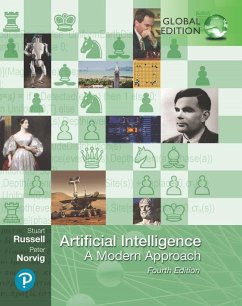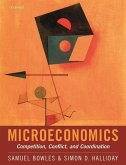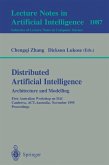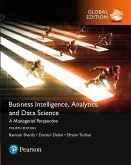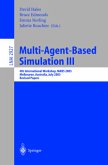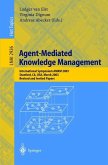- Broschiertes Buch
- Merkliste
- Auf die Merkliste
- Bewerten Bewerten
- Teilen
- Produkt teilen
- Produkterinnerung
- Produkterinnerung
This title is a Pearson Global Edition. The Editorial team at Pearson has worked closely with educators around the world to include content which is especially relevant to students outside the United States.
The most comprehensive, up-to-date introductionto the theory and practice of artificial intelligence
The long-anticipated revision of ArtificialIntelligence: A Modern Approach explores the full breadth and depth of the field of artificial intelligence (AI). The 4th Edition brings readers up to date on the latest technologies, presents concepts in a more unified manner, and offers new…mehr
Andere Kunden interessierten sich auch für
![The Cambridge Handbook of Japanese Linguistics The Cambridge Handbook of Japanese Linguistics]() The Cambridge Handbook of Japanese Linguistics59,99 €
The Cambridge Handbook of Japanese Linguistics59,99 €![Microeconomics Microeconomics]() Samuel BowlesMicroeconomics80,99 €
Samuel BowlesMicroeconomics80,99 €![Distributed Artificial Intelligence: Architecture and Modelling Distributed Artificial Intelligence: Architecture and Modelling]() ZhangDistributed Artificial Intelligence: Architecture and Modelling41,99 €
ZhangDistributed Artificial Intelligence: Architecture and Modelling41,99 €![Business Intelligence: A Managerial Approach, Global Edition Business Intelligence: A Managerial Approach, Global Edition]() David KingBusiness Intelligence: A Managerial Approach, Global Edition51,99 €
David KingBusiness Intelligence: A Managerial Approach, Global Edition51,99 €![Multi-Agent-Based Simulation III Multi-Agent-Based Simulation III]() David Hales / Bruce Edmonds / Emma Norling / Juliette Rouchier (eds.)Multi-Agent-Based Simulation III41,99 €
David Hales / Bruce Edmonds / Emma Norling / Juliette Rouchier (eds.)Multi-Agent-Based Simulation III41,99 €![The Role of Norms and Electronic Institutions in Multi-Agent Systems The Role of Norms and Electronic Institutions in Multi-Agent Systems]() Javier Vazquez-SalcedaThe Role of Norms and Electronic Institutions in Multi-Agent Systems33,99 €
Javier Vazquez-SalcedaThe Role of Norms and Electronic Institutions in Multi-Agent Systems33,99 €![Agent-Mediated Knowledge Management Agent-Mediated Knowledge Management]() Ludger van Elst / Virginia Dignum / Andreas Abecker (Bearb.)Agent-Mediated Knowledge Management41,99 €
Ludger van Elst / Virginia Dignum / Andreas Abecker (Bearb.)Agent-Mediated Knowledge Management41,99 €-
-
-
-
-
This title is a Pearson Global Edition. The Editorial team at Pearson has worked closely with educators around the world to include content which is especially relevant to students outside the United States.
The most comprehensive, up-to-date introductionto the theory and practice of artificial intelligence
The long-anticipated revision of ArtificialIntelligence: A Modern Approach explores the full breadth and depth of the field of artificial intelligence (AI). The 4th Edition brings readers up to date on the latest technologies, presents concepts in a more unified manner, and offers new or expanded coverage of machine learning, deep learning, transfer learning, multi agent systems, robotics, natural language processing, causality, probabilistic programming, privacy, fairness, and safe AI.
The most comprehensive, up-to-date introductionto the theory and practice of artificial intelligence
The long-anticipated revision of ArtificialIntelligence: A Modern Approach explores the full breadth and depth of the field of artificial intelligence (AI). The 4th Edition brings readers up to date on the latest technologies, presents concepts in a more unified manner, and offers new or expanded coverage of machine learning, deep learning, transfer learning, multi agent systems, robotics, natural language processing, causality, probabilistic programming, privacy, fairness, and safe AI.
Produktdetails
- Produktdetails
- Verlag: Pearson / Pearson Deutschland GmbH
- 4. Aufl.
- Seitenzahl: 1168
- Erscheinungstermin: 13. Mai 2021
- Englisch
- Abmessung: 253mm x 203mm x 45mm
- Gewicht: 2096g
- ISBN-13: 9781292401133
- ISBN-10: 1292401133
- Artikelnr.: 61444391
- Herstellerkennzeichnung
- Pearson
- St.-Martin-Straße 82
- 81541 München
- salesde@pearson.com
- +4989541960460
- Verlag: Pearson / Pearson Deutschland GmbH
- 4. Aufl.
- Seitenzahl: 1168
- Erscheinungstermin: 13. Mai 2021
- Englisch
- Abmessung: 253mm x 203mm x 45mm
- Gewicht: 2096g
- ISBN-13: 9781292401133
- ISBN-10: 1292401133
- Artikelnr.: 61444391
- Herstellerkennzeichnung
- Pearson
- St.-Martin-Straße 82
- 81541 München
- salesde@pearson.com
- +4989541960460
Stuart Russell was born in 1962 in Portsmouth, England. He received his B.A. with first-class honours in physics from Oxford University in 1982, and his Ph.D. in computer science from Stanford in 1986. He then joined the faculty of the University of California, Berkeley, where he is a Professor and former Chair of Computer Science, Director of the Centre for Human-Compatible AI, and holder of the SmithZadeh Chair in Engineering. In 1990, he received the Presidential Young Investigator Award of the National Science Foundation, and in 1995 he was co-winner of the Computers and Thought Award. He is a Fellow of the American Association for Artificial Intelligence, the Association for Computing Machinery, and the American Association for the Advancement of Science, and Honorary Fellow of Wadham College, Oxford, and an Andrew Carnegie Fellow. He held the Chaire Blaise Pascal in Paris from 2012 to 2014. He has published over 300 papers on a wide range of topics in artificial intelligence. His other books include: The Use of Knowledge in Analogy and Induction, Do the Right Thing: Studies in Limited Rationality (with Eric Wefald), and Human Compatible: Artificial Intelligence and the Problem of Control. Peter Norvig is currently Director of Research at Google, Inc., and was the director responsible for the core Web search algorithms from 2002 to 2005. He is a Fellow of the American Association for Artificial Intelligence and the Association for Computing Machinery. Previously, he was head of the Computational Sciences Division at NASA Ames Research Center, where he oversaw NASA's research and development in artificial intelligence and robotics, and chief scientist at Junglee, where he helped develop one of the first Internet information extraction services. He received a B.S. in applied mathematics from Brown University and a Ph.D. in computer science from the University of California at Berkeley. He received the Distinguished Alumni and Engineering Innovation awards from Berkeley and the Exceptional Achievement Medal from NASA. He has been a professor at the University of Southern California and are research faculty member at Berkeley. His other books are: Paradigms of AI Programming: Case Studies in Common Lisp, Verbmobil: A Translation System for Face-to-Face Dialog, and Intelligent Help Systems for UNIX. The two authors shared the inaugural AAAI/EAAI Outstanding Educator award in 2016.
Chapter I Artificial Intelligence
1. Introduction
o What Is AI?
o The Foundations of Artificial Intelligence
o The History of Artificial Intelligence
o The State of the Art
o Risks and Benefits of AI
SummaryBibliographical and Historical Notes
2. Intelligent Agents
o Agents and Environments
o Good Behavior: The Concept of Rationality
o The Nature of Environments
o The Structure of Agents
SummaryBibliographical and Historical NotesChapter II Problem Solving
3. Solving Problems by Searching
o Problem-Solving Agents
o Example Problems
o Search Algorithms
o Uninformed Search Strategies
o Informed (Heuristic) Search Strategies
o Heuristic Functions
SummaryBibliographical and Historical Notes
4. Search in Complex Environments
o Local Search and Optimization Problems
o Local Search in Continuous Spaces
o Search with Nondeterministic Actions
o Search in Partially Observable Environments
o Online Search Agents and Unknown Environments
SummaryBibliographical and Historical Notes
5. Constraint Satisfaction Problems
o Defining Constraint Satisfaction Problems
o Constraint Propagation: Inference in CSPs
o Backtracking Search for CSPs
o Local Search for CSPs
o The Structure of Problems
SummaryBibliographical and Historical Notes
6. Adversarial Search and Games
o Game Theory
o Optimal Decisions in Games
o Heuristic Alpha--Beta Tree Search
o Monte Carlo Tree Search
o Stochastic Games
o Partially Observable Games
o Limitations of Game Search Algorithms
SummaryBibliographical and Historical NotesChapter III Knowledge,
Reasoning and Planning
7. Logical Agents
o Knowledge-Based Agents
o The Wumpus World
o Logic
o Propositional Logic: A Very Simple Logic
o Propositional Theorem Proving
o Effective Propositional Model Checking
o Agents Based on Propositional Logic
SummaryBibliographical and Historical Notes
8. First-Order Logic
o Representation Revisited
o Syntax and Semantics of First-Order Logic
o Using First-Order Logic
o Knowledge Engineering in First-Order Logic
SummaryBibliographical and Historical Notes
9. Inference in First-Order Logic
o Propositional vs. First-Order Inference
o Unification and First-Order Inference
o Forward Chaining
o Backward Chaining
o Resolution
SummaryBibliographical and Historical Notes
10. Knowledge Representation
o Ontological Engineering
o Categories and Objects
o Events
o Mental Objects and Modal Logic
o for Categories
o Reasoning with Default Information
SummaryBibliographical and Historical Notes
11. Automated Planning
o Definition of Classical Planning
o Algorithms for Classical Planning
o Heuristics for Planning
o Hierarchical Planning
o Planning and Acting in Nondeterministic Domains
o Time, Schedules, and Resources
o Analysis of Planning Approaches
SummaryBibliographical and Historical NotesChapter IV Uncertain
Knowledge and Reasoning
12. Quantifying Uncertainty
o Acting under Uncertainty
o Basic Probability Notation
o Inference Using Full Joint Distributions
o Independence 12.5 Bayes' Rule and Its Use
o Naive Bayes Models
o The Wumpus World Revisited
SummaryBibliographical and Historical Notes
13. Probabilistic Reasoning
o Representing Knowledge in an Uncertain Domain
o The Semantics of Bayesian Networks
o Exact Inference in Bayesian Networks
o Approximate Inference for Bayesian Networks
o Causal Networks
SummaryBibliographical and Historical Notes
14. Probabilistic Reasoning over Time
o Time and Uncertainty
o Inference in Temporal Models
o Hidden Markov Models
o Kalman Filters
o Dynamic Bayesian Networks
SummaryBibliographical and Historical Notes
15. Making Simple Decisions
o Combining Beliefs and Desires under Uncertainty
o The Basis of Utility Theory
o Utility Functions
o Multiattribute Utility Functions
o Decision Networks
o The Value of Information
o Unknown Preferences
SummaryBibliographical and Historical Notes
16. Making Complex Decisions
o Sequential Decision Problems
o Algorithms for MDPs
o Bandit Problems
o Partially Observable MDPs
o Algorithms for Solving POMDPs
SummaryBibliographical and Historical Notes
17. Multiagent Decision Making
o Properties of Multiagent Environments
o Non-Cooperative Game Theory
o Cooperative Game Theory
o Making Collective Decisions
SummaryBibliographical and Historical Notes
18. Probabilistic Programming
o Relational Probability Models
o Open-Universe Probability Models
o Keeping Track of a Complex World
o Programs as Probability Models
SummaryBibliographical and Historical NotesChapter V Machine Learning
19. Learning from Examples
o Forms of Leaming
o Supervised Learning .
o Learning Decision Trees .
o Model Selection and Optimization
o The Theory of Learning
o Linear Regression and Classification
o Nonparametric Models
o Ensemble Learning
o Developing Machine Learning Systen
SummaryBibliographical and Historical Notes
20. Knowledge in Learning
o A Logical Formulation of Learning
o Knowledge in Learning
o Exmplanation-Based Leaening
o Learning Using Relevance Information
o Inductive Logic Programming
SummaryBibliographical and Historical Notes
21. Learning Probabilistic Models
o Statistical Learning
o Learning with Complete Data
o Learning with Hidden Variables: The EM Algorithm
SummaryBibliographical and Historical Notes
22. Deep Learning
o Simple Feedforward Networks
o Computation Graphs for Deep Learning
o Convolutional Networks
o Learning Algorithms
o Generalization
o Recurrent Neural Networks
o Unsupervised Learning and Transfer Learning
o Applications
SummaryBibliographical and Historical Notes
23. Reinforcement Learning
o Learning from Rewards
o Passive Reinforcement Learning
o Active Reinforcement Learning
o Generalization in Reinforcement Learning
o Policy Search
o Apprenticeship and Inverse Reinforcement Leaming
o Applications of Reinforcement Learning
SummaryBibliographical and Historical NotesChapter VI Communicating,
perceiving, and acting
24. Natural Language Processing
o Language Models
o Grammar
o Parsing
o Augmented Grammars
o Complications of Real Natural Languagr
o Natural Language Tasks
SummaryBibliographical and Historical Notes
25. Deep Learning for Natural Language Processing
o Word Embeddings
o Recurrent Neural Networks for NLP
o Sequence-to-Sequence Models
o The Transformer Architecture
o Pretraining and Transfer Learning
o State of the art
SummaryBibliographical and Historical Notes
26. Robotics
o Robots
o Robot Hardware
o What kind of problem is robotics solving?
o Robotic Perception
o Planning and Control
o Planning Uncertain Movements
o Reinforcement Laming in Robotics
o Humans and Robots
o Alternative Robotic Frameworks
o Application Domains
SummaryBibliographical and Historical Notes
27. Computer Vision
o Introduction
o Image Formation
o Simple Image Features
o Classifying Images
o Detecting Objects
o The 3D World
o Using Computer Vision
SummaryBibliographical and Historical NotesChapter VII Conclusions
28. Philosophy, Ethics, and Safety of Al
o The Limits of Al
o Can Machines Really Think?
o The Ethics of Al
SummaryBibliographical and Historical Notes
29. The Future of AI
o Al Components
o Al Architectures
* A.1 Complexity Analysis and O0 Notation
* A.2 Vectors, Matrices, and Linear Algebra
* A.3 Probability Distributions
* Bibliographical and Historical Notes
* B.1 Defining Languages with Backus-Naur Form (BNF)
* B.2 Describing Algorithms with Pseudocode
* B.3 Online Supplemental Material
Bibliography
Index
1. Introduction
o What Is AI?
o The Foundations of Artificial Intelligence
o The History of Artificial Intelligence
o The State of the Art
o Risks and Benefits of AI
SummaryBibliographical and Historical Notes
2. Intelligent Agents
o Agents and Environments
o Good Behavior: The Concept of Rationality
o The Nature of Environments
o The Structure of Agents
SummaryBibliographical and Historical NotesChapter II Problem Solving
3. Solving Problems by Searching
o Problem-Solving Agents
o Example Problems
o Search Algorithms
o Uninformed Search Strategies
o Informed (Heuristic) Search Strategies
o Heuristic Functions
SummaryBibliographical and Historical Notes
4. Search in Complex Environments
o Local Search and Optimization Problems
o Local Search in Continuous Spaces
o Search with Nondeterministic Actions
o Search in Partially Observable Environments
o Online Search Agents and Unknown Environments
SummaryBibliographical and Historical Notes
5. Constraint Satisfaction Problems
o Defining Constraint Satisfaction Problems
o Constraint Propagation: Inference in CSPs
o Backtracking Search for CSPs
o Local Search for CSPs
o The Structure of Problems
SummaryBibliographical and Historical Notes
6. Adversarial Search and Games
o Game Theory
o Optimal Decisions in Games
o Heuristic Alpha--Beta Tree Search
o Monte Carlo Tree Search
o Stochastic Games
o Partially Observable Games
o Limitations of Game Search Algorithms
SummaryBibliographical and Historical NotesChapter III Knowledge,
Reasoning and Planning
7. Logical Agents
o Knowledge-Based Agents
o The Wumpus World
o Logic
o Propositional Logic: A Very Simple Logic
o Propositional Theorem Proving
o Effective Propositional Model Checking
o Agents Based on Propositional Logic
SummaryBibliographical and Historical Notes
8. First-Order Logic
o Representation Revisited
o Syntax and Semantics of First-Order Logic
o Using First-Order Logic
o Knowledge Engineering in First-Order Logic
SummaryBibliographical and Historical Notes
9. Inference in First-Order Logic
o Propositional vs. First-Order Inference
o Unification and First-Order Inference
o Forward Chaining
o Backward Chaining
o Resolution
SummaryBibliographical and Historical Notes
10. Knowledge Representation
o Ontological Engineering
o Categories and Objects
o Events
o Mental Objects and Modal Logic
o for Categories
o Reasoning with Default Information
SummaryBibliographical and Historical Notes
11. Automated Planning
o Definition of Classical Planning
o Algorithms for Classical Planning
o Heuristics for Planning
o Hierarchical Planning
o Planning and Acting in Nondeterministic Domains
o Time, Schedules, and Resources
o Analysis of Planning Approaches
SummaryBibliographical and Historical NotesChapter IV Uncertain
Knowledge and Reasoning
12. Quantifying Uncertainty
o Acting under Uncertainty
o Basic Probability Notation
o Inference Using Full Joint Distributions
o Independence 12.5 Bayes' Rule and Its Use
o Naive Bayes Models
o The Wumpus World Revisited
SummaryBibliographical and Historical Notes
13. Probabilistic Reasoning
o Representing Knowledge in an Uncertain Domain
o The Semantics of Bayesian Networks
o Exact Inference in Bayesian Networks
o Approximate Inference for Bayesian Networks
o Causal Networks
SummaryBibliographical and Historical Notes
14. Probabilistic Reasoning over Time
o Time and Uncertainty
o Inference in Temporal Models
o Hidden Markov Models
o Kalman Filters
o Dynamic Bayesian Networks
SummaryBibliographical and Historical Notes
15. Making Simple Decisions
o Combining Beliefs and Desires under Uncertainty
o The Basis of Utility Theory
o Utility Functions
o Multiattribute Utility Functions
o Decision Networks
o The Value of Information
o Unknown Preferences
SummaryBibliographical and Historical Notes
16. Making Complex Decisions
o Sequential Decision Problems
o Algorithms for MDPs
o Bandit Problems
o Partially Observable MDPs
o Algorithms for Solving POMDPs
SummaryBibliographical and Historical Notes
17. Multiagent Decision Making
o Properties of Multiagent Environments
o Non-Cooperative Game Theory
o Cooperative Game Theory
o Making Collective Decisions
SummaryBibliographical and Historical Notes
18. Probabilistic Programming
o Relational Probability Models
o Open-Universe Probability Models
o Keeping Track of a Complex World
o Programs as Probability Models
SummaryBibliographical and Historical NotesChapter V Machine Learning
19. Learning from Examples
o Forms of Leaming
o Supervised Learning .
o Learning Decision Trees .
o Model Selection and Optimization
o The Theory of Learning
o Linear Regression and Classification
o Nonparametric Models
o Ensemble Learning
o Developing Machine Learning Systen
SummaryBibliographical and Historical Notes
20. Knowledge in Learning
o A Logical Formulation of Learning
o Knowledge in Learning
o Exmplanation-Based Leaening
o Learning Using Relevance Information
o Inductive Logic Programming
SummaryBibliographical and Historical Notes
21. Learning Probabilistic Models
o Statistical Learning
o Learning with Complete Data
o Learning with Hidden Variables: The EM Algorithm
SummaryBibliographical and Historical Notes
22. Deep Learning
o Simple Feedforward Networks
o Computation Graphs for Deep Learning
o Convolutional Networks
o Learning Algorithms
o Generalization
o Recurrent Neural Networks
o Unsupervised Learning and Transfer Learning
o Applications
SummaryBibliographical and Historical Notes
23. Reinforcement Learning
o Learning from Rewards
o Passive Reinforcement Learning
o Active Reinforcement Learning
o Generalization in Reinforcement Learning
o Policy Search
o Apprenticeship and Inverse Reinforcement Leaming
o Applications of Reinforcement Learning
SummaryBibliographical and Historical NotesChapter VI Communicating,
perceiving, and acting
24. Natural Language Processing
o Language Models
o Grammar
o Parsing
o Augmented Grammars
o Complications of Real Natural Languagr
o Natural Language Tasks
SummaryBibliographical and Historical Notes
25. Deep Learning for Natural Language Processing
o Word Embeddings
o Recurrent Neural Networks for NLP
o Sequence-to-Sequence Models
o The Transformer Architecture
o Pretraining and Transfer Learning
o State of the art
SummaryBibliographical and Historical Notes
26. Robotics
o Robots
o Robot Hardware
o What kind of problem is robotics solving?
o Robotic Perception
o Planning and Control
o Planning Uncertain Movements
o Reinforcement Laming in Robotics
o Humans and Robots
o Alternative Robotic Frameworks
o Application Domains
SummaryBibliographical and Historical Notes
27. Computer Vision
o Introduction
o Image Formation
o Simple Image Features
o Classifying Images
o Detecting Objects
o The 3D World
o Using Computer Vision
SummaryBibliographical and Historical NotesChapter VII Conclusions
28. Philosophy, Ethics, and Safety of Al
o The Limits of Al
o Can Machines Really Think?
o The Ethics of Al
SummaryBibliographical and Historical Notes
29. The Future of AI
o Al Components
o Al Architectures
* A.1 Complexity Analysis and O0 Notation
* A.2 Vectors, Matrices, and Linear Algebra
* A.3 Probability Distributions
* Bibliographical and Historical Notes
* B.1 Defining Languages with Backus-Naur Form (BNF)
* B.2 Describing Algorithms with Pseudocode
* B.3 Online Supplemental Material
Bibliography
Index
Chapter I Artificial Intelligence
1. Introduction
o What Is AI?
o The Foundations of Artificial Intelligence
o The History of Artificial Intelligence
o The State of the Art
o Risks and Benefits of AI
SummaryBibliographical and Historical Notes
2. Intelligent Agents
o Agents and Environments
o Good Behavior: The Concept of Rationality
o The Nature of Environments
o The Structure of Agents
SummaryBibliographical and Historical NotesChapter II Problem Solving
3. Solving Problems by Searching
o Problem-Solving Agents
o Example Problems
o Search Algorithms
o Uninformed Search Strategies
o Informed (Heuristic) Search Strategies
o Heuristic Functions
SummaryBibliographical and Historical Notes
4. Search in Complex Environments
o Local Search and Optimization Problems
o Local Search in Continuous Spaces
o Search with Nondeterministic Actions
o Search in Partially Observable Environments
o Online Search Agents and Unknown Environments
SummaryBibliographical and Historical Notes
5. Constraint Satisfaction Problems
o Defining Constraint Satisfaction Problems
o Constraint Propagation: Inference in CSPs
o Backtracking Search for CSPs
o Local Search for CSPs
o The Structure of Problems
SummaryBibliographical and Historical Notes
6. Adversarial Search and Games
o Game Theory
o Optimal Decisions in Games
o Heuristic Alpha--Beta Tree Search
o Monte Carlo Tree Search
o Stochastic Games
o Partially Observable Games
o Limitations of Game Search Algorithms
SummaryBibliographical and Historical NotesChapter III Knowledge,
Reasoning and Planning
7. Logical Agents
o Knowledge-Based Agents
o The Wumpus World
o Logic
o Propositional Logic: A Very Simple Logic
o Propositional Theorem Proving
o Effective Propositional Model Checking
o Agents Based on Propositional Logic
SummaryBibliographical and Historical Notes
8. First-Order Logic
o Representation Revisited
o Syntax and Semantics of First-Order Logic
o Using First-Order Logic
o Knowledge Engineering in First-Order Logic
SummaryBibliographical and Historical Notes
9. Inference in First-Order Logic
o Propositional vs. First-Order Inference
o Unification and First-Order Inference
o Forward Chaining
o Backward Chaining
o Resolution
SummaryBibliographical and Historical Notes
10. Knowledge Representation
o Ontological Engineering
o Categories and Objects
o Events
o Mental Objects and Modal Logic
o for Categories
o Reasoning with Default Information
SummaryBibliographical and Historical Notes
11. Automated Planning
o Definition of Classical Planning
o Algorithms for Classical Planning
o Heuristics for Planning
o Hierarchical Planning
o Planning and Acting in Nondeterministic Domains
o Time, Schedules, and Resources
o Analysis of Planning Approaches
SummaryBibliographical and Historical NotesChapter IV Uncertain
Knowledge and Reasoning
12. Quantifying Uncertainty
o Acting under Uncertainty
o Basic Probability Notation
o Inference Using Full Joint Distributions
o Independence 12.5 Bayes' Rule and Its Use
o Naive Bayes Models
o The Wumpus World Revisited
SummaryBibliographical and Historical Notes
13. Probabilistic Reasoning
o Representing Knowledge in an Uncertain Domain
o The Semantics of Bayesian Networks
o Exact Inference in Bayesian Networks
o Approximate Inference for Bayesian Networks
o Causal Networks
SummaryBibliographical and Historical Notes
14. Probabilistic Reasoning over Time
o Time and Uncertainty
o Inference in Temporal Models
o Hidden Markov Models
o Kalman Filters
o Dynamic Bayesian Networks
SummaryBibliographical and Historical Notes
15. Making Simple Decisions
o Combining Beliefs and Desires under Uncertainty
o The Basis of Utility Theory
o Utility Functions
o Multiattribute Utility Functions
o Decision Networks
o The Value of Information
o Unknown Preferences
SummaryBibliographical and Historical Notes
16. Making Complex Decisions
o Sequential Decision Problems
o Algorithms for MDPs
o Bandit Problems
o Partially Observable MDPs
o Algorithms for Solving POMDPs
SummaryBibliographical and Historical Notes
17. Multiagent Decision Making
o Properties of Multiagent Environments
o Non-Cooperative Game Theory
o Cooperative Game Theory
o Making Collective Decisions
SummaryBibliographical and Historical Notes
18. Probabilistic Programming
o Relational Probability Models
o Open-Universe Probability Models
o Keeping Track of a Complex World
o Programs as Probability Models
SummaryBibliographical and Historical NotesChapter V Machine Learning
19. Learning from Examples
o Forms of Leaming
o Supervised Learning .
o Learning Decision Trees .
o Model Selection and Optimization
o The Theory of Learning
o Linear Regression and Classification
o Nonparametric Models
o Ensemble Learning
o Developing Machine Learning Systen
SummaryBibliographical and Historical Notes
20. Knowledge in Learning
o A Logical Formulation of Learning
o Knowledge in Learning
o Exmplanation-Based Leaening
o Learning Using Relevance Information
o Inductive Logic Programming
SummaryBibliographical and Historical Notes
21. Learning Probabilistic Models
o Statistical Learning
o Learning with Complete Data
o Learning with Hidden Variables: The EM Algorithm
SummaryBibliographical and Historical Notes
22. Deep Learning
o Simple Feedforward Networks
o Computation Graphs for Deep Learning
o Convolutional Networks
o Learning Algorithms
o Generalization
o Recurrent Neural Networks
o Unsupervised Learning and Transfer Learning
o Applications
SummaryBibliographical and Historical Notes
23. Reinforcement Learning
o Learning from Rewards
o Passive Reinforcement Learning
o Active Reinforcement Learning
o Generalization in Reinforcement Learning
o Policy Search
o Apprenticeship and Inverse Reinforcement Leaming
o Applications of Reinforcement Learning
SummaryBibliographical and Historical NotesChapter VI Communicating,
perceiving, and acting
24. Natural Language Processing
o Language Models
o Grammar
o Parsing
o Augmented Grammars
o Complications of Real Natural Languagr
o Natural Language Tasks
SummaryBibliographical and Historical Notes
25. Deep Learning for Natural Language Processing
o Word Embeddings
o Recurrent Neural Networks for NLP
o Sequence-to-Sequence Models
o The Transformer Architecture
o Pretraining and Transfer Learning
o State of the art
SummaryBibliographical and Historical Notes
26. Robotics
o Robots
o Robot Hardware
o What kind of problem is robotics solving?
o Robotic Perception
o Planning and Control
o Planning Uncertain Movements
o Reinforcement Laming in Robotics
o Humans and Robots
o Alternative Robotic Frameworks
o Application Domains
SummaryBibliographical and Historical Notes
27. Computer Vision
o Introduction
o Image Formation
o Simple Image Features
o Classifying Images
o Detecting Objects
o The 3D World
o Using Computer Vision
SummaryBibliographical and Historical NotesChapter VII Conclusions
28. Philosophy, Ethics, and Safety of Al
o The Limits of Al
o Can Machines Really Think?
o The Ethics of Al
SummaryBibliographical and Historical Notes
29. The Future of AI
o Al Components
o Al Architectures
* A.1 Complexity Analysis and O0 Notation
* A.2 Vectors, Matrices, and Linear Algebra
* A.3 Probability Distributions
* Bibliographical and Historical Notes
* B.1 Defining Languages with Backus-Naur Form (BNF)
* B.2 Describing Algorithms with Pseudocode
* B.3 Online Supplemental Material
Bibliography
Index
1. Introduction
o What Is AI?
o The Foundations of Artificial Intelligence
o The History of Artificial Intelligence
o The State of the Art
o Risks and Benefits of AI
SummaryBibliographical and Historical Notes
2. Intelligent Agents
o Agents and Environments
o Good Behavior: The Concept of Rationality
o The Nature of Environments
o The Structure of Agents
SummaryBibliographical and Historical NotesChapter II Problem Solving
3. Solving Problems by Searching
o Problem-Solving Agents
o Example Problems
o Search Algorithms
o Uninformed Search Strategies
o Informed (Heuristic) Search Strategies
o Heuristic Functions
SummaryBibliographical and Historical Notes
4. Search in Complex Environments
o Local Search and Optimization Problems
o Local Search in Continuous Spaces
o Search with Nondeterministic Actions
o Search in Partially Observable Environments
o Online Search Agents and Unknown Environments
SummaryBibliographical and Historical Notes
5. Constraint Satisfaction Problems
o Defining Constraint Satisfaction Problems
o Constraint Propagation: Inference in CSPs
o Backtracking Search for CSPs
o Local Search for CSPs
o The Structure of Problems
SummaryBibliographical and Historical Notes
6. Adversarial Search and Games
o Game Theory
o Optimal Decisions in Games
o Heuristic Alpha--Beta Tree Search
o Monte Carlo Tree Search
o Stochastic Games
o Partially Observable Games
o Limitations of Game Search Algorithms
SummaryBibliographical and Historical NotesChapter III Knowledge,
Reasoning and Planning
7. Logical Agents
o Knowledge-Based Agents
o The Wumpus World
o Logic
o Propositional Logic: A Very Simple Logic
o Propositional Theorem Proving
o Effective Propositional Model Checking
o Agents Based on Propositional Logic
SummaryBibliographical and Historical Notes
8. First-Order Logic
o Representation Revisited
o Syntax and Semantics of First-Order Logic
o Using First-Order Logic
o Knowledge Engineering in First-Order Logic
SummaryBibliographical and Historical Notes
9. Inference in First-Order Logic
o Propositional vs. First-Order Inference
o Unification and First-Order Inference
o Forward Chaining
o Backward Chaining
o Resolution
SummaryBibliographical and Historical Notes
10. Knowledge Representation
o Ontological Engineering
o Categories and Objects
o Events
o Mental Objects and Modal Logic
o for Categories
o Reasoning with Default Information
SummaryBibliographical and Historical Notes
11. Automated Planning
o Definition of Classical Planning
o Algorithms for Classical Planning
o Heuristics for Planning
o Hierarchical Planning
o Planning and Acting in Nondeterministic Domains
o Time, Schedules, and Resources
o Analysis of Planning Approaches
SummaryBibliographical and Historical NotesChapter IV Uncertain
Knowledge and Reasoning
12. Quantifying Uncertainty
o Acting under Uncertainty
o Basic Probability Notation
o Inference Using Full Joint Distributions
o Independence 12.5 Bayes' Rule and Its Use
o Naive Bayes Models
o The Wumpus World Revisited
SummaryBibliographical and Historical Notes
13. Probabilistic Reasoning
o Representing Knowledge in an Uncertain Domain
o The Semantics of Bayesian Networks
o Exact Inference in Bayesian Networks
o Approximate Inference for Bayesian Networks
o Causal Networks
SummaryBibliographical and Historical Notes
14. Probabilistic Reasoning over Time
o Time and Uncertainty
o Inference in Temporal Models
o Hidden Markov Models
o Kalman Filters
o Dynamic Bayesian Networks
SummaryBibliographical and Historical Notes
15. Making Simple Decisions
o Combining Beliefs and Desires under Uncertainty
o The Basis of Utility Theory
o Utility Functions
o Multiattribute Utility Functions
o Decision Networks
o The Value of Information
o Unknown Preferences
SummaryBibliographical and Historical Notes
16. Making Complex Decisions
o Sequential Decision Problems
o Algorithms for MDPs
o Bandit Problems
o Partially Observable MDPs
o Algorithms for Solving POMDPs
SummaryBibliographical and Historical Notes
17. Multiagent Decision Making
o Properties of Multiagent Environments
o Non-Cooperative Game Theory
o Cooperative Game Theory
o Making Collective Decisions
SummaryBibliographical and Historical Notes
18. Probabilistic Programming
o Relational Probability Models
o Open-Universe Probability Models
o Keeping Track of a Complex World
o Programs as Probability Models
SummaryBibliographical and Historical NotesChapter V Machine Learning
19. Learning from Examples
o Forms of Leaming
o Supervised Learning .
o Learning Decision Trees .
o Model Selection and Optimization
o The Theory of Learning
o Linear Regression and Classification
o Nonparametric Models
o Ensemble Learning
o Developing Machine Learning Systen
SummaryBibliographical and Historical Notes
20. Knowledge in Learning
o A Logical Formulation of Learning
o Knowledge in Learning
o Exmplanation-Based Leaening
o Learning Using Relevance Information
o Inductive Logic Programming
SummaryBibliographical and Historical Notes
21. Learning Probabilistic Models
o Statistical Learning
o Learning with Complete Data
o Learning with Hidden Variables: The EM Algorithm
SummaryBibliographical and Historical Notes
22. Deep Learning
o Simple Feedforward Networks
o Computation Graphs for Deep Learning
o Convolutional Networks
o Learning Algorithms
o Generalization
o Recurrent Neural Networks
o Unsupervised Learning and Transfer Learning
o Applications
SummaryBibliographical and Historical Notes
23. Reinforcement Learning
o Learning from Rewards
o Passive Reinforcement Learning
o Active Reinforcement Learning
o Generalization in Reinforcement Learning
o Policy Search
o Apprenticeship and Inverse Reinforcement Leaming
o Applications of Reinforcement Learning
SummaryBibliographical and Historical NotesChapter VI Communicating,
perceiving, and acting
24. Natural Language Processing
o Language Models
o Grammar
o Parsing
o Augmented Grammars
o Complications of Real Natural Languagr
o Natural Language Tasks
SummaryBibliographical and Historical Notes
25. Deep Learning for Natural Language Processing
o Word Embeddings
o Recurrent Neural Networks for NLP
o Sequence-to-Sequence Models
o The Transformer Architecture
o Pretraining and Transfer Learning
o State of the art
SummaryBibliographical and Historical Notes
26. Robotics
o Robots
o Robot Hardware
o What kind of problem is robotics solving?
o Robotic Perception
o Planning and Control
o Planning Uncertain Movements
o Reinforcement Laming in Robotics
o Humans and Robots
o Alternative Robotic Frameworks
o Application Domains
SummaryBibliographical and Historical Notes
27. Computer Vision
o Introduction
o Image Formation
o Simple Image Features
o Classifying Images
o Detecting Objects
o The 3D World
o Using Computer Vision
SummaryBibliographical and Historical NotesChapter VII Conclusions
28. Philosophy, Ethics, and Safety of Al
o The Limits of Al
o Can Machines Really Think?
o The Ethics of Al
SummaryBibliographical and Historical Notes
29. The Future of AI
o Al Components
o Al Architectures
* A.1 Complexity Analysis and O0 Notation
* A.2 Vectors, Matrices, and Linear Algebra
* A.3 Probability Distributions
* Bibliographical and Historical Notes
* B.1 Defining Languages with Backus-Naur Form (BNF)
* B.2 Describing Algorithms with Pseudocode
* B.3 Online Supplemental Material
Bibliography
Index

